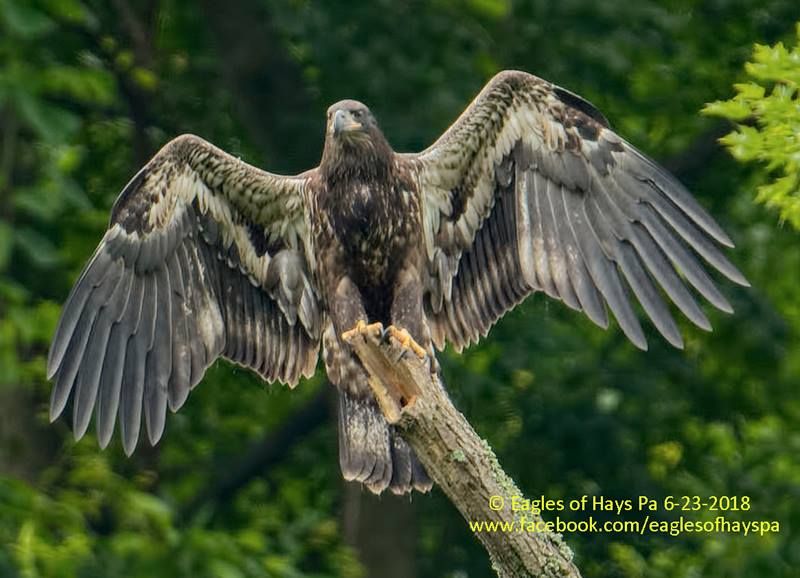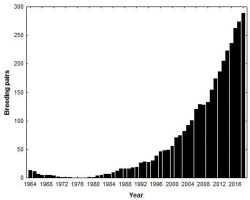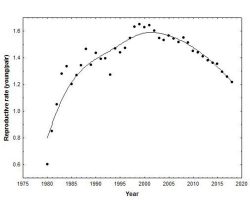
Bald eagles have made an amazing comeback since the days of DDT. From less than 900 birds nationwide in the early 1960s to more than 20,000 in the U.S. in 2007, their population more than doubled in Pennsylvania in the last 10 years.
At some point the number of nesting bald eagles will reach Pennsylvania’s carrying capacity. What happens then? How do bald eagles respond to match available food and nest sites? We can look to Virginia for the answer.
Since 1964 the Center for Conservation Biology in Williamsburg has monitored and mapped bald eagle nests in the James River watershed. Every year they do a flyover of the entire area to count both nests and chicks. Their eagle population grew from none in 1976 to a record 289 nests in 2018. Meanwhile the number of chicks per nest — called “productivity” — rose sharply in the early years of recovery and now is dropping. CCB announced this trend in two articles:
- Eagle Productivity Continues to Slide, July 2018 –and–
- James River Eagle Recovery Enters Final Chapter, July 2017
To see how this works, I have made a slideshow of two graphs from the Center for Conservation Biology’s article. The bar chart is the count of nesting pairs, 0 to 289. The line chart, the arc, is the average number of chicks per nest, 0 to 1.6.
As you can see, the number of nesting pairs continues to increase while the number of chicks per nest moves down.
CCB reports that in 2018 the number of chicks reached 1.09 and adds, “The two opposing trends appear to continue the population’s path to stability.”
“Productivity decline” sounds bad but it’s actually good news. Breeding eagles respond naturally to accommodate lots of adults in the habitat.
So what does this mean for Pennsylvania’s bald eagles?
If the James River experience applies here, we’ll still see an increasing number of bald eagle nests that will eventually average one eaglet per nest. We know bald eagles can produce more if they need to. The good news is, they don’t need to.
p.s. See how rapidly the James River nest count grew! Click here for CCB’s maps of the James River bald eagle population, 1990-2017.
(photo of juvenile bald eagle H8 at the Hays nest site by Dana Nesiti. Slideshow of two graphs from the Center for Conservation Biology article Eagle Productivity Continues to Slide.)


Thank You Kate, makes total sense!
More food is available to the surviving
Check out Pam at Unalaska. Eagles looking like a herd of pidgeons eating popcorn.
Great info! Has there been any study of how the increasing nesting/breeding pairs affects the wintering, migrant population of eagles? Since breeding pairs are territorial, one would think wintering birds would be pushed out as competition for food increases?
Lori, solo wintering birds are pushed along but large congregations gather on the major rivers such as the Susquehanna and Mississippi.
Over the last 20 years I have followed the same nesting male eagle through three nests, two females and 39 chicks. During the last 10 years of this time frame I may have checked on 10-15 different nesting pairs during nesting season. During 2018 nesting season four nesting pairs that were incubating produced no eaglets because of other eagles or birds. As their numbers keep rising I think they have become their own worst enemy.
Has H8 been seen recently?
Julie, I haven’t heard any recent news of H8. However, the adults are building a new nest! See Eagles of Hays PA on Facebook for photos and information. https://www.facebook.com/eaglesofhayspa